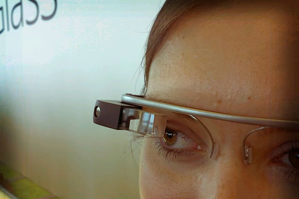What can Glass do for your health? Quite a bit.

Last week I got to sit in on the end-of-year presentations for associate professors Stephen Initlle and Rupal Patel’s class, Reinventing healthcare with Google Glass. You can read all about the class in this story on the News@Northeastern, but for more in depth details on the individual projects, you’ve come to the right place.
Step By Step
The adult world is a busy, complicated, and nuanced place. For the one in 88 children diagnosed with autism spectrum disorders, entering this world can be even more daunting that it is for the rest of us. One group of students in Intille and Patel’s class developed an app for Google Glass that helps young adults with autism independently navigate through tasks that present particular challenges for them, like grocery shopping. One of the defining features of their app, which is called Step By Step, is the way it teaches users through an iterative, phasing process. First, the user carries out the task (which is clearly broken down into discrete steps) with a caretaker. Then, using the “alone together” feature, the user does the task alone but with video conferencing support with the caretaker at a remote location. Finally, he reaches a point where he can do it completely alone, feeling safe in the knowledge that at any point the caretaker can be easily called using Glass’ contact list. Check out this video to see how it works:
My Intelligible Speech Therapy (MIST)
People with speech language disorders, including Parkinson’s disease, have long benefited from a therapy technique called Lee Silverman Voice Treatment, or LSVT. Patients are asked to talk while having some kind of white noise piped into their ears that they have to talk over. The developers of MIST wanted to use Google Glass to improve on LSVT, which does not adapt to a user’s environment provides no long term or real time feedback. With MIST, Google Glass users see a visual representation of their vocal output which tells them whether they should increase their volume or decrease it, based on the level of ambient noise nearby. The app then stores the data and generates reports on the user’s improvement over time.
Social Lens
This is another app designed for people with autism, but a younger age group. This one turns social skills development into a game for kids with autism. five to eight kids in a group with on therapist are assigned social scavenger hunt challenges, like making eye contact during a conversation with each other. The kids’ apps notify them they’ve got a challenge, which they then go and try to complete. Their Google Glass captures a point-of-view video of their conversation, for example, which the therapist then gets to watch and evaluate. Over time, the caregivers can see how the kids are doing over time, analyze which situations they’re succeeding in most often, and assign more challenges targeted at the individual kids’ particular needs.
Checked
This one is actually a tool for clinicians, not patients, but it certainly could have major positive impacts for the latter group. Medical errors account for somewhere between 44,000 and 98,000 deaths each year. Considering the fact that there are roughly 6,000 drugs, 13,000 diseases, and 4,000 procedures out there, it’s not all that hard to guess why. Doctors are human and no human can keep track of that much information. That’s why checklists, like those used in the aviation industry, have been infiltrating the healthcare industry in recent years. “Checklists are revolutionizing medicine,” the team that built Checked said. “Google Glass will revolutionize checklists.” Checked is an app that allows clinicians to run through their chekclists before performing a procedure without needing to hold a tablet or smartphone, which we’ve recently learned are ground zero for parasite colonization. Here’s a video demoing the app in action (shout out to the new Goldstein Simulation Center too!):
Bridge
This app was designed for older adults, 40 percent of whom report feelings of loneliness. This may sound trite, but loneliness is actually associated with a three times higher five-year mortality rate, increased risk of cardiovascular disease as well as other health conditions. A full third of older adults now live alone, and Bridge aims to help them combat the threat of loneliness. Touch screens embedded around the home give users the ability to connect with family all with the guidance of a relational agent (see here for more info on relational agents). They can use Google Glass to augment this existing system, by taking point-of-view images of a person’s activities to send to family members at remote locations. If the family member hasn’t heard from their loved one in a few days, they can remotely force Glass to take a photo of whatever he or she is looking at, to make sure everything is okay.






